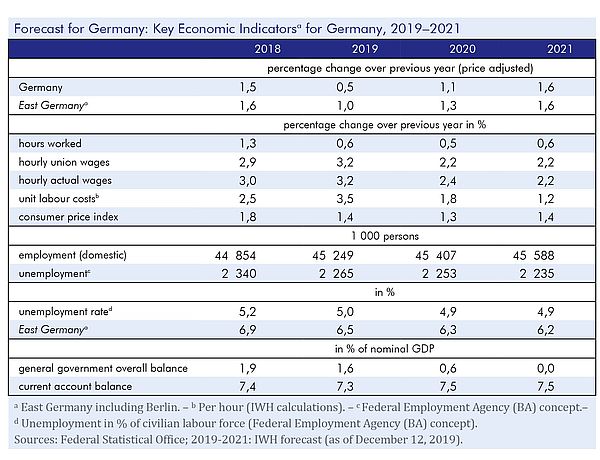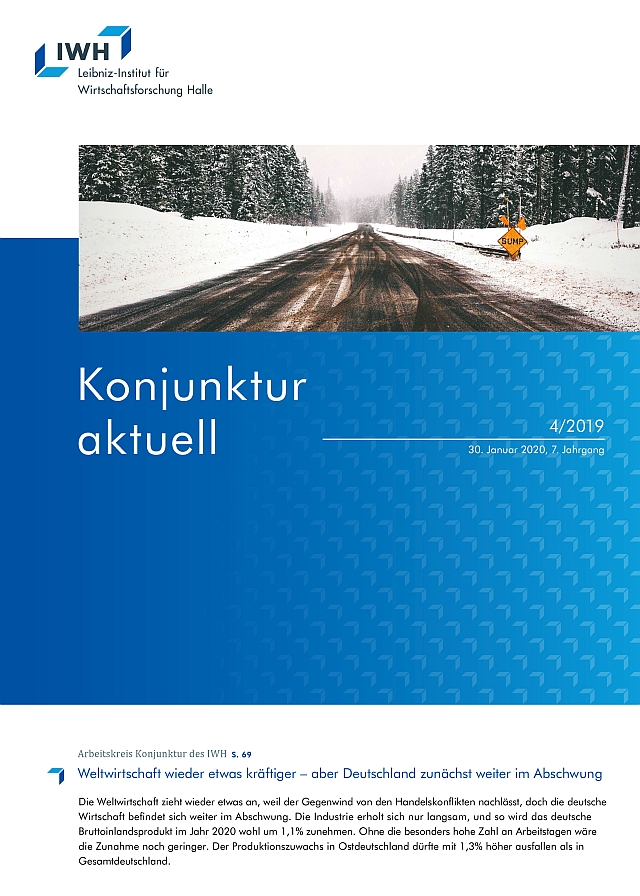Global economy slowly gains momentum – but Germany still stuck in a downturn

The international economy
Since autumn 2019, there have been signs of easing trade tensions, and the risk of a hard Brexit has reduced markedly. Despite these developments, recent production data do not yet indicate substantial improvements in the international economy. Also owing to below-target inflation rates in many advanced economies, central banks have shifted to a more expansionary monetary policy stance. Without further flare-ups in trade tensions, the downturn in the manufacturing sector will probably bottom out until early 2020. The political framework underpinning international trade, however, will remain fragile. Indeed, the lasting uncertainty with respect to international trade is a major factor preventing the world economy from a strong rebound over the forecast period. In addition, the contributions to global growth from the economic powerhouse China are likely to diminish further.
The German economy
The German economy is still in a downturn, struggling with weak foreign demand for manufacturing products due to protectionist policies in the US and due to the immanent Brexit. The shift in Chinese demand from industrial goods to services also weighs particularly heavy on German exporters. Another factor straining the German economy is the pending transition from combustion to electric engines in the automotive industry. In 2020, a slight upturn in the international economy will probably lead to increased demand for industrial goods benefitting German exports. Due to rising unit labour costs, the increase in German exports will however be limited. On the other hand, the already sizeable wage increases aid in stabilising the German economy in the current downturn through bolstering domestic demand. Furthermore, fiscal policy continues to be expansionary, and the favorable financing conditions accompanied by a housing shortage in urban areas are likely to sustain the current construction boom. “Overall, the German economy is expected to pick up pace slowly in the course of 2020”, Holtemöller adds. Consumer price inflation is expected to remain moderate throughout the forecast period, and employment will increase only slightly.
A renewed escalation of the trade conflicts between the US and China or the European Union poses the greatest downward risk to the current outlook. Additionally, a deterioration in asset prices, particularly in the US and in Japan, could quickly erode global financing conditions. A specific risk to the German economy remains the transition of the automotive industry towards electric propulsion. The associated structural change may prove to be a higher burden to the economy than assumed here. The decline in purchasing power, which would accompany a crisis in the automotive sector, could noticeably dampen aggregate demand in Germany.
Extended version of this forecast: "Konjunktur aktuell: Weltwirtschaft wieder etwas kräftiger – aber Deutschland zunächst weiter im Abschwung".
Publication
Brautzsch, Hans-Ulrich; Claudio, João Carlos; Drygalla, Andrej; Exß, Franziska; Heinisch, Katja; Holtemöller, Oliver; Kämpfe, Martina; Lindner, Axel; Müller, Isabella; Schultz, Birgit; Staffa, Ruben; Wieschemeyer, Matthias; Zeddies, Götz: Konjunktur aktuell: Weltwirtschaft wieder etwas kräftiger – aber Deutschland zunächst weiter im Abschwung. Konjunktur aktuell, Jg. 7 (4), 2019. Halle (Saale) 2019, forthcoming.
Whom to contact
For Researchers

Vice President Department Head
If you have any further questions please contact me.
+49 345 7753-800 Request per E-MailFor Journalists

Press Officer
If you have any further questions please contact me.
+49 345 7753-765 Request per E-MailIWH list of experts
The IWH list of experts provides an overview of IWH research topics and the researchers and scientists in these areas. The relevant experts for the topics listed there can be reached for questions as usual through the IWH Press Office.
Related Publications

Konjunktur aktuell: Weltwirtschaft wieder etwas kräftiger – aber Deutschland zunächst weiter im Abschwung
in: Konjunktur aktuell, 4, 2019
Abstract
Im Jahr 2020 zieht die Weltwirtschaft wieder etwas an, weil der Gegenwind von den Handelskonflikten nachlässt. Die jüngsten Produktionsdaten deuten allerdings noch nicht auf eine durchgreifende Besserung der internationalen Konjunktur hin. Auch wegen der niedrigen Preisdynamik ist die Geldpolitik im Lauf des Jahres vielerorts noch einmal expansiver geworden. Wenn weitere Zollerhebungen im Wesentlichen ausbleiben, dürfte der Abschwung im Verarbeitenden Gewerbe um die Jahreswende 2019/2020 zu Ende gehen. Allerdings bleibt die Zukunft der politischen Rahmenbedingungen für den internationalen Handel unsicher. Das ist ein wichtiger Grund, warum mit einem kräftigen weltwirtschaftlichen Aufschwung für den Prognosezeitraum nicht zu rechnen ist. Zudem dürfte die Expansion der Nachfrage aus China weiter nachlassen. Die deutsche Wirtschaft befindet sich weiter im Abschwung. Ursache ist im Wesentlichen die schwache Auslandsnachfrage nach Produkten des Verarbeitenden Gewerbes, bedingt durch die von den USA ausgehenden protektionistischen Tendenzen und den bevorstehenden Brexit. Als weiterer Faktor kommen die Probleme im Automobilbau hinzu, denn die Branche steht mit am Beginn eines drastischen Strukturwandels. Im Jahr 2020 dürfte eine leichte Belebung der internationalen Konjunktur den deutschen Export wieder anziehen lassen. Der Anstieg wird aber nicht allzu hoch ausfallen, nicht zuletzt, weil die Lohnstückkosten seit einiger Zeit deutlich zugenommen haben. Auf der anderen Seite stabilisieren die recht deutlichen Lohnzuwächse die binnenwirtschaftliche Nachfrage. Zudem wirkt die Finanzpolitik expansiv, und die günstigen Finanzierungsbedingungen werden zusammen mit der Wohnungsknappheit in Ballungsräumen den Bauboom am Leben halten. Das Bruttoinlandsprodukt wird im Jahr 2020 wohl um 1,1% zunehmen, auch dank einer hohen Zahl an Arbeitstagen. Der Produktionszuwachs in Ostdeutschland dürfte mit 1,3% höher ausfallen als in Gesamtdeutschland. Die Verbraucherpreisinflation bleibt moderat, die Beschäftigung nimmt nur noch wenig zu.



